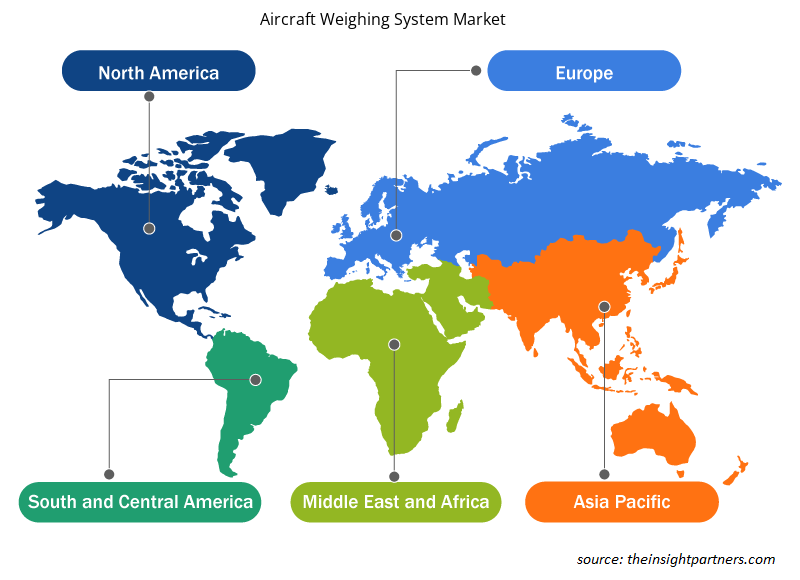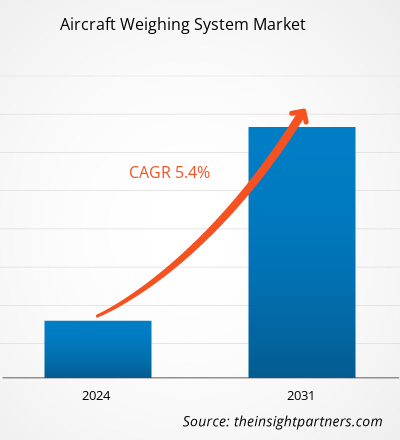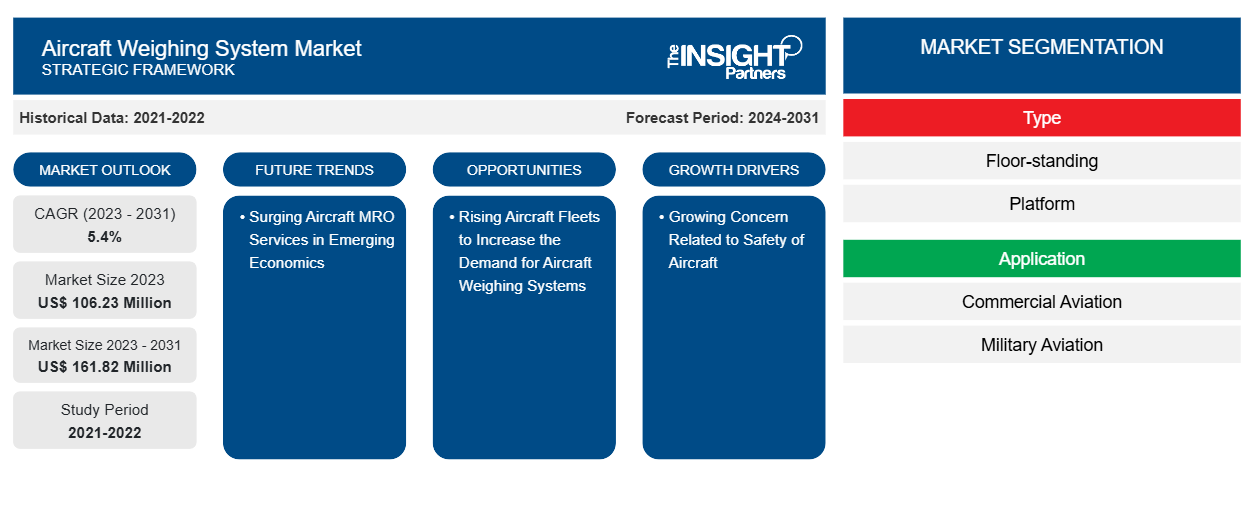항공기 계량 시스템 시장 규모는 2023년 1억 623만 달러에서 2031년까지 1억 6182만 달러로 성장할 것으로 예상됩니다. 이 시장은 2023~2031년 동안 5.4%의 CAGR을 기록할 것으로 예상됩니다. 신흥 경제권에서 급증하는 항공기 MRO 서비스는 시장의 주요 추세로 남을 가능성이 높습니다.
항공기 무게 측정 시스템 시장 분석
항공기 저울 제조업체로는 Intercomp, Vishay Precision Group, General Electrodynamics Corp 등이 있습니다. 많은 수의 구성 요소 공급업체를 이용할 수 있으므로 항공기 저울 시스템 제조업체는 적절한 공급업체를 선택할 수 있습니다. 이를 통해 구성 요소의 공급망이 향상됩니다. 구성 요소를 조달하면 항공기 저울 시스템 OEM은 상당한 양의 항공기 저울 시스템을 생산하여 해당 고객 요구 사항을 충족합니다. 최종 사용자로는 항공기 OEM, MRO 공급업체, 군대가 있습니다. Airbus 및 Boeing과 같은 항공기 OEM, AAR Corporation 및 Lufthansa Technik과 같은 항공기 MRO, 군대는 제조업체로부터 항공기 저울 시스템을 조달합니다. 상업용 및 군용 항공기의 생산 속도가 증가함에 따라 항공기 저울 시스템 수요는 예측 기간 동안 꾸준히 증가할 것으로 예상됩니다.
항공기 무게 측정 시스템 시장 개요
항공기 계량 시스템 시장 생태계는 구성 요소 공급업체, 항공기 계량 저울 제조업체, 최종 사용자와 같은 이해 관계자로 구성됩니다. 제조업체는 고객의 장착 요구 사항을 충족하는 항공기 계량 시스템을 제조하기 위해 구성 요소 공급업체로부터 디스플레이, 센서, 패드와 같은 다양한 구성 요소를 지속적으로 조달합니다.
귀하의 요구 사항에 맞게 이 보고서를 사용자 정의하세요
이 보고서의 일부 또는 국가 수준 분석, Excel 데이터 팩을 포함하여 모든 보고서에 대한 사용자 정의를 무료로 받을 수 있으며 신생 기업 및 대학을 위한 훌륭한 혜택과 할인 혜택을 이용할 수 있습니다.
-
이 보고서의 주요 시장 동향을 알아보세요.이 무료 샘플에는 시장 동향부터 추정 및 예측까지 다양한 데이터 분석이 포함됩니다.
항공기 무게 측정 시스템 시장 동인 및 기회
항공기 안전과 관련된 우려가 커지면서 시장이 유리해지고 있다
화물 항공편의 중량 관련 사고 위험은 적재표 오류와 잘못된 적재로 인해 여객 항공편보다 훨씬 높습니다. 다양한 저명한 항공기 계량 시스템 시장 참여자는 모든 유형의 항공기에 대한 효율적인 계량 시스템을 개발하고 생산하는 데 적극적으로 참여하고 있습니다. 효율적인 항공기 계량 시스템을 설계하는 데 다양한 회사가 참여하고 다양한 요인으로 인한 항공기 사고를 피하는 데 정부가 상당한 중점을 두는 것은 모든 지역에서 항공기 계량 시스템에 대한 수요를 촉진하는 매개변수이며, 이를 통해 항공기 계량 저울을 촉진합니다.
항공기 함대 증가로 항공기 무게 시스템 수요 증가
모든 지역의 여러 제조업체는 유연성과 비용 효율성을 갖춘 광범위한 차세대 항공 운송 시스템을 만드는 데 중점을 두고 있습니다. Airbus 및 Boeing과 같은 주요 항공기 OEM은 항공기 계량 시스템 시장 참여자에게 엄청난 기회를 제공하고 있습니다. 이 항공기는 운영자가 주로 중국에서 호주 또는 인도에서 유럽으로 가는 덜 자주 이용하는 노선에서 새로운 장거리 서비스를 개설할 수 있도록 합니다. 또한 아시아 여러 국가에 Boeing 및 Airbus 제조/조립 공장이 문을 열고 COMAC C919 및 Mitsubishi MRJ와 같은 토종 지역 상업 및 지역 항공기가 출시되면 향후 몇 년 동안 항공기 계량 시스템 시장이 계속 활성화될 것입니다.
항공기 무게 측정 시스템 시장 보고서 세분화 분석
항공기 계량 시스템 시장 분석에 기여한 주요 세그먼트는 유형과 응용 분야입니다.
- 항공기 무게 측정 시스템 시장은 유형에 따라 플로어 스탠딩과 플랫폼으로 나뉩니다. 플로어 스탠딩 세그먼트는 2023년에 더 큰 시장 점유율을 차지했습니다.
- 응용 프로그램을 기준으로 항공기 무게 측정 시스템 시장은 상업 항공과 군용 항공으로 나뉩니다. 상업 항공 부문은 2023년에 더 큰 시장 점유율을 차지했습니다.
지역별 항공기 무게 측정 시스템 시장 점유율 분석
항공기 계량 시스템 시장 보고서의 지리적 범위는 주로 북미, 아시아 태평양, 유럽, 중동 및 아프리카, 남미 및 중부 아메리카의 5개 지역으로 나뉩니다.
항공기 계량 시스템 시장 보고서의 범위는 북미(미국, 캐나다, 멕시코), 유럽(러시아, 영국, 프랑스, 독일, 이탈리아, 유럽의 나머지 지역), 아시아 태평양(한국, 인도, 호주, 일본, 중국, 아시아 태평양의 나머지 지역), 중동 및 아프리카(사우디 아라비아, 남아프리카, UAE, 중동 및 아프리카의 나머지 지역), 남중부 아메리카(아르헨티나, 브라질, 남중부 아메리카의 나머지 지역)를 포함합니다. 수익 측면에서 북미는 2023년 항공기 계량 시스템 시장 점유율을 지배했습니다. 유럽은 글로벌 항공기 계량 시스템 시장에 두 번째로 큰 기여자이며, 그 다음은 아시아 태평양입니다.
항공기 무게 측정 시스템 시장 지역 통찰력
Insight Partners의 분석가들은 예측 기간 동안 항공기 중량 시스템 시장에 영향을 미치는 지역적 추세와 요인을 철저히 설명했습니다. 이 섹션에서는 북미, 유럽, 아시아 태평양, 중동 및 아프리카, 남미 및 중미의 항공기 중량 시스템 시장 세그먼트와 지리에 대해서도 설명합니다.

- 항공기 무게 시스템 시장에 대한 지역별 특정 데이터 얻기
항공기 무게 측정 시스템 시장 보고서 범위
| 보고서 속성 | 세부 |
|---|---|
| 2023년 시장 규모 | 1억 623만 달러 |
| 2031년까지 시장 규모 | 1억 6,182만 달러 |
| 글로벌 CAGR (2023-2031) | 5.4% |
| 역사적 데이터 | 2021-2022 |
| 예측 기간 | 2024-2031 |
| 다루는 세그먼트 |
유형별로
|
| 포함된 지역 및 국가 |
북아메리카
|
| 시장 선도 기업 및 주요 회사 프로필 |
|
항공기 무게 측정 시스템 시장 참여자 밀도: 비즈니스 역학에 미치는 영향 이해
항공기 무게 측정 시스템 시장은 소비자 선호도의 변화, 기술 발전, 제품의 이점에 대한 인식 증가와 같은 요인으로 인해 최종 사용자 수요가 증가함에 따라 빠르게 성장하고 있습니다. 수요가 증가함에 따라 기업은 제품을 확장하고, 소비자의 요구를 충족하기 위해 혁신하고, 새로운 트렌드를 활용하여 시장 성장을 더욱 촉진하고 있습니다.
시장 참여자 밀도는 특정 시장이나 산업 내에서 운영되는 회사나 기업의 분포를 말합니다. 주어진 시장 공간에 얼마나 많은 경쟁자(시장 참여자)가 존재하는지 그 규모나 전체 시장 가치에 비해 나타냅니다.
항공기 중량 시스템 시장에서 운영되는 주요 회사는 다음과 같습니다.
- 제너럴 일렉트로다이내믹스 코퍼레이션
- 헨크 마스 위그샬렌 BV
- 인터컴 회사
- 잭슨 항공기 무게 시스템 LLC
- 랑가 인더스트리얼 SA
- 비샤이 프리시전 그룹 주식회사
면책 조항 : 위에 나열된 회사는 어떤 특별한 순서에 따라 순위가 매겨지지 않았습니다.

- 항공기 무게 측정 시스템 시장 주요 주요 업체 개요를 알아보세요
항공기 무게 측정 시스템 시장 뉴스 및 최근 개발
항공기 계량 시스템 시장은 1차 및 2차 조사 이후의 정성적, 정량적 데이터를 수집하여 평가합니다. 여기에는 중요한 기업 간행물, 협회 데이터 및 데이터베이스가 포함됩니다. 항공기 계량 시스템 시장의 몇 가지 개발 사항은 다음과 같습니다.
- 휴대용 차량 계량 및 측정 제품 생산업체인 Intercomp가 글로벌 산업용 저울 시장에 LTR788 듀얼 플랫폼 저울을 출시한다고 발표했습니다. LTR788은 상업용 차량 중량 시행을 위해 NTEP 인증을 받았습니다. (출처: Intercomp Company, 보도자료, 2024년 4월)
- Intercomp Company는 Airborne Maintenance MRO로부터 AC60-LP 항공기 저울 시스템을 제공하기 위한 계약을 체결했습니다. (출처: Intercomp Company, 보도자료, 2020년 8월)
항공기 무게 측정 시스템 시장 보고서 범위 및 제공물
"항공기 무게 시스템 시장 규모 및 예측(2021-2031)" 보고서는 아래 영역을 포괄하는 시장에 대한 자세한 분석을 제공합니다.
- 범위에 포함된 모든 주요 시장 세그먼트에 대한 글로벌, 지역 및 국가 수준의 항공기 계량 시스템 시장 규모 및 예측
- 항공기 무게 측정 시스템 시장 동향 및 운전자, 제지장치, 주요 기회와 같은 시장 역학
- 자세한 PEST 및 SWOT 분석
- 주요 시장 동향, 글로벌 및 지역 프레임워크, 주요 업체, 규정 및 최근 시장 개발 사항을 포괄하는 항공기 계량 시스템 시장 분석
- 시장 집중도, 히트맵 분석, 유명 업체 및 항공기 계량 시스템 시장의 최근 개발 사항을 다루는 산업 환경 및 경쟁 분석
- 자세한 회사 프로필
- 과거 분석(2년), 기준 연도, CAGR을 포함한 예측(7년)
- PEST 및 SWOT 분석
- 시장 규모 가치/거래량 - 글로벌, 지역, 국가
- 산업 및 경쟁 환경
- Excel 데이터세트
최근 보고서
사용 후기
구매 이유
- 정보에 기반한 의사 결정
- 시장 역학 이해
- 경쟁 분석
- 고객 인사이트
- 시장 예측
- 위험 완화
- 전략 기획
- 투자 타당성 분석
- 신흥 시장 파악
- 마케팅 전략 강화
- 운영 효율성 향상
- 규제 동향에 발맞춰 대응























 무료 샘플 받기 - 항공기 중량 측정 시스템 시장
무료 샘플 받기 - 항공기 중량 측정 시스템 시장